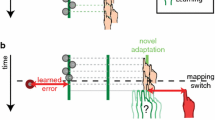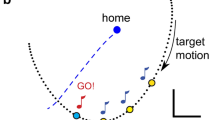Abstract
The coordination of the oculomotor and manual effector systems is an important component of daily motor behavior. Previous work has primarily examined oculomotor/manual coordination in discrete targeting tasks. Here we extend this work to learning a tracking task that requires continuous response and movement update. Over two sessions, participants practiced controlling a computer mouse with movements of their arm to follow a target moving in a repeated sequence. Eye movements were also recorded. In a retention test, participants demonstrated sequence-specific learning with both effector systems, but differences between effectors also were apparent. Time series analysis and multiple linear regression were employed to probe spatial and temporal contributions to overall tracking accuracy within each effector system. Sequence-specific oculomotor learning occurred only in the spatial domain. By contrast, sequence-specific learning at the arm was evident only in the temporal domain. There was minimal interdependence in error rates for the two effector systems, underscoring their independence during tracking. These findings suggest that the oculomotor and manual systems learn contemporaneously, but performance improvements manifest differently and rely on different elements of motor execution. The results may in part be a function of what the motor learning system values for each effector as a function of its effector’s inertial properties.



Similar content being viewed by others
References
Aron A, Aron EA (1999) Statistics for psychology. Prentice-Hall, Upper Saddle River
Barnes GR, Schmid AM (2002) Sequence learning in human ocular smooth pursuit. Exp Brain Res 144:322–335
Binsted G, Elliott D (1999) Ocular perturbations and retinal/extraretinal information: the coordination of saccadic and manual movements. Exp Brain Res 127:193–206
Boyd LA, Winstein CJ (2004) Cerebellar stroke impairs temporal but not spatial accuracy during implicit motor learning. Neurorehabil Neural Rep 18:134–143
Burke MR, Barnes GR (2007) Sequence learning in two-dimensional smooth pursuit eye movements in humans. J Vis 7:5
Day BL, Marsden CD (1982) Two strategies for learning a visually guided motor task. Percept Mot Skills 55:1003–1016
Desmurget M, Pelisson D, Rossetti Y, Prablanc C (1998) From eye to hand: planning goal-directed movements. Neurosci Biobehav Rev 22:761–788
Epelboim J, Steinman RM, Kowler E, Pizlo Z, Erkelens CJ, Collewijn H (1997) Gaze-shift dynamics in two kinds of sequential looking tasks. Vision Res 37:2597–2607
Gordon J, Ghilardi MF, Cooper SE, Ghez C (1994) Accuracy of planar reaching movements. II. Systematic extent errors resulting from inertial anisotropy. Exp Brain Res 99:112–130
Hatada Y, Rossetti Y, Miall RC (2006) Long-lasting aftereffect of a single prism adaptation: shifts in vision and proprioception are independent. Exp Brain Res 173:415–424
Helsen WF, Elliott D, Starkes JL, Ricker KL (2000) Coupling of eye, finger, elbow and shoulder movements during manual aiming. J Mot Behav 32:241–248
Helsen WF, Tremblay L, Van den Berg M, Elliott D (2004) The Role of oculomotor information in the learning of sequential aiming movements. J Mot Behav 36:82–90
Hikosaka O, Rand MK, Miyachi S, Miyashita K (1995) Learning of sequential movements in the monkey: process of learning and retention of memory. J Neurophysiol 74:1652–1661
Hirata C, Yoshida S (2000) Visual dominance in amending the directional parameter of feedforward control. J Mot Behav 32:17–25
Johansson RS, Westling G, Backstrom A, Flanagan JR (2001) Eye-hand coordination in object manipulation. J Neurosci 21:6917–6932
Kowler E, Steinman RM (1979a) The effect of expectations on slow oculomotor control. I. Periodic target steps. Vision Res 19:619–632
Kowler E, Steinman RM (1979b) The effect of expectations on slow oculomotor control. II. Single target displacements. Vision Res 19:633–646
Kowler E, Steinman RM (1981) Th effect of expectations on slow oculomotor control. III. Guessing unpredictable target displacements. Vision Res 21:191–203
Kowler E, Martins AJ, Pavel M (1984) The effect of expectations on slow oculomotor control. IV. Anticipatory smooth eye movements depend on prior target motions. Vision Res 24:197–210
Land MF, Hayhoe M (2001) In what ways do eye movements contribute to everyday activities? Vision Res 41:3559–3565
Lateiner JE, Sainburg RL (2003) Differential contributions of vision and proprioception to movement accuracy. Exp Brain Res 151:446–454
Lazzari S, Vercher JL, Buizza A (1997) Manuo-ocular coordination in target tracking. I. A model simulating human performance. Biol Cybern 77:257–266
Leigh JR, Zee DS (2006) The neurology of eye movement. Oxford University Press, New York
Mackrous I, Proteau L (2007) Specificity of practice results from differences in movement planning strategies. Exp Brain Res 183:181–193
Marcus DJ, Karatekin C, Markiewicz S (2006) Oculomotor evidence of sequence learning on the serial reaction time task. Mem Cognit 34:420–432
McHugh DE, Bahill AT (1985) Learning to track predictable target waveforms without a time delay. Invest Ophthalmol Vis Sci 26:932–937
Miall RC, Jenkinson EW (2005) Functional imaging of changes in cerebellar activity related to learning during a novel eye-hand tracking task. Exp Brain Res 166:170–183
Miall RC, Reckess GZ, Imamizu H (2001) The cerebellum coordinates eye and hand tracking movements. Nat Neurosci 4:638–644
Miyashita K, Rand MK, Miyachi S, Hikosaka O (1996) Anticipatory saccades in sequential procedural learning in monkeys. J Neurophysiol 76:1361–1366
Pew RW (1974) Levels of analysis in motor control. Brain Res 71:393–400
Ren L, Khan AZ, Blohm G, Henriques DY, Sergio LE, Crawford JD (2006) Proprioceptive guidance of saccades in eye-hand coordination. J Neurophysiol 96:1464–1477
Sailer U, Flanagan JR, Johansson RS (2005) Eye-hand coordination during learning of a novel visuomotor task. J Neurosci 25:8833–8842
Salmoni AW, Schmidt RA, Walter CB (1984) Knowledge of results and motor learning: a review and critical reappraisal. Psychol Bull 95:355–386
Schmidt RA, Lee TD (1999) Motor control and learning: a behavioral approach. Human Kinetics, Champaign
Shea CH, Park JH, Braden HW (2006) Age-related effects in sequential motor learning. Phys Ther 86:478–488
S-R Research Ltd (2006) Eyelink II Users Manual V 2.12
Starkes J, Helsen W, Elliott D (2002) A menage a trois: the eye, the hand and on-line processing. J Sports Sci 20:217–224
van Donkelaar P (1997) Eye–hand interactions during goal-directed pointing movements. Neuroreport 8:2139–2142
Vaziri S, Diedrichsen J, Shadmehr R (2006) Why does the brain predict sensory consequences of oculomotor commands? Optimal integration of the predicted and the actual sensory feedback. J Neurosci 26:4188–4197
Vercher JL, Lazzari S, Gauthier G (1997) Manuo-ocular coordination in target tracking. II. Comparing the model with human behavior. Biol Cybern 77:267–275
Vidoni ED, Boyd LA (2008) Motor sequence learning occurs despite disrupted visual and proprioceptive feedback. Behav Brain Funct 4:32
Wulf G, Schmidt RA (1997) Variability of practice and implicit motor learning. J Exp Psychol Learn Mem Cogn 23:987–1006
Acknowledgments
We appreciate the helpful comments of Jeff Radel and Robyn Honea and the thoughtful and constructive reviewers of the manuscript. Funding was provided by start-up monies from the University of Kansas Medical Center awarded to LAB.
Author information
Authors and Affiliations
Corresponding author
Rights and permissions
About this article
Cite this article
Vidoni, E.D., McCarley, J.S., Edwards, J.D. et al. Manual and oculomotor performance develop contemporaneously but independently during continuous tracking. Exp Brain Res 195, 611–620 (2009). https://doi.org/10.1007/s00221-009-1833-2
Received:
Accepted:
Published:
Issue Date:
DOI: https://doi.org/10.1007/s00221-009-1833-2




